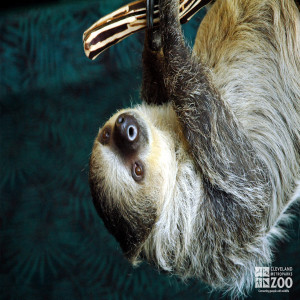Linne's Two-Toed Sloth
[Choloepus didactylus]

The hair of Linne's two toed sloth is coarse and grooved. The grooves are filled with greenish algae, which helps conceal the animal in its forest home. Males and females are alike in appearance. Sloths have no canine teeth, but their first premolars have a sharp fang-like cusp that gives the appearance of canine teeth and enable the animal to inflict a serious wound. They are about 2 feet long and weigh 10-15 pounds. They have a very flexible neck that enables them to reach all around themselves without moving.
Sloths are the most spectacularly successful large mammals in Central and South America. In many places they account for one fourth to two-thirds of the total mammalian biomass and half of the energy consumption of all terrestrial mammals. This success is largely because the effects of competitors and predators are scarcely perceptible. They eat what very few other mammals want, and most predators do not detect them. The metabolic rate of sloths is slow -- about 40 to 45% of that of a comparably-sized terrestrial mammal.
Share:
Range
The range of Linne's two toed sloth is Central America and northern South America.
Habitat
Linne's two toed sloths inhabit rainforests.
Conservation Status
Least ConcernPrimary Threats
Gestation
Gestation lasts approximately 5 months.
Litter
1
Behavior
Linne's two toed sloths spend most of their lives upside down, moving very slowly through the trees.The most important sense for sloths is smell. They spend 15-18 hours of every 24 in sleep. The rest of the time they are grinding up leaves and fruit and slowly digesting their meal (it may take up to a month) in a large compartmentalized stomach containing cellulose-digesting bacteria. They descend about once a week to defecate. They usually urinate only when rain can mask their urine stream.
Reproduction
In coupling, both animals hang from a branch by their forelimbs, face to face. The breeding season is March and April. One young Linne's two toed sloth is born about every 14-16 months. They mature in 3.5 years for females and 5 years for males. The infant is carried on its mother’s upturned belly.
Wild Diet
Tender shoots, leaves, fruits, blossoms
Zoo Diet
Fruit and vegetables
